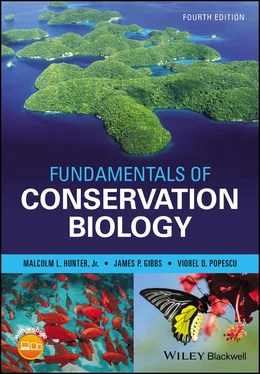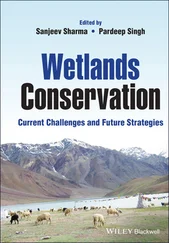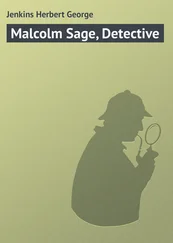Definitions of biodiversity usually go one step beyond the obvious – the diversity of life – and define biodiversity as the variety of life in all its forms and at all levels of organization. “In all its forms” reminds us that biodiversity includes plants, invertebrate animals, fungi, bacteria, and other microorganisms, as well as the vertebrate animals that garner most of the attention. “All levels of organization” indicates that biodiversity refers to the diversity of genes and ecosystems, as well as species diversity. The idea that biodiversity has levels of organization introduces a complexity that we will explore in the next three chapters, “Species Diversity,” “Ecosystem Diversity,” and “Genetic Diversity,” after a brief overview here. (For a novel approach to understanding biological complexity, see Kim et al. [2019] and their analysis of biochemical networks that reach from individual organisms to the whole biosphere.)
Species, Genes, and Ecosystems
It is easiest to comprehend the idea of maintaining biodiversity in terms of species that are threatened with extinction. We know about blue whales, giant pandas, and whooping cranes, and we would experience a sense of loss if they were to disappear, even though most of us have never encountered them except as digital representations in an electronic medium. For most mosses, lichens, fungi, insects, and other obscure species it is much harder to elicit concern. Nevertheless, many people are prepared to extend some of the feelings they have for whales, pandas, and cranes to species they do not know, as an expression of their belief that all species have some intrinsic value.
Genes can also be hard to understand and appreciate. These self‐replicating pieces of DNA that shape the form and function of each individual organism are the organism’s fundamental blueprint, but also important are water, oxygen, and thousands of other molecules. It is not the genes themselves that conservation biologists value; it is the diversity that they impart to organisms that is so essential. If two individual strawberry plants have a different set of genes, one of them might be better adapted to fluctuations in water availability and thus would be more likely to survive a period of climate change. One of them might be less susceptible to damage from ozone and other types of air pollution. The fruit of one might be more resistant to rotting and therefore its progeny might prove useful to strawberry breeders and farmers. Perhaps the fruits simply taste or look different and thereby provide aesthetic diversity. It is these expressions of genetic diversity that we value. The diversity of life is rooted in genetic differences among individuals and the processes of evolution that amplified and shaped these differences among populations to generate distinct species and ultimately the higher taxonomic levels: genera, families, orders, and so on.
Unlike genes, ecosystems are large and conspicuous, and thus anyone with the most rudimentary understanding of ecology appreciates the value of a lake, a forest, a wetland, and so on. Nevertheless, ecosystems can be hard to define in practice. Where do you draw the boundary between a lake and the marsh that surrounds it when many organisms are moving back and forth between the two? This sort of problem can complicate the role of ecosystems in biodiversity conservation. Conservation biologists often advocate protecting examples of all the different types of ecosystems in a region, but how finely should differences be recognized? Is an oak–pine forest ecosystem that is 60% oak and 40% pine appreciably different from one that is 40% oak and 60% pine? If you look hard enough, every ecosystem will be unique. The rationale for protecting ecosystem diversity also differs. Some conservationists advocate protecting ecosystems for their intrinsic value as independent, biological entities of many interacting species, whereas others think of protecting ecosystems simply as an efficient way to protect most of the species that form the ecosystem.
The definition of biodiversity provided above emphasizes structure – forms of life and levels of organization – but sometimes ecological and evolutionary functions or processes are also included in a definition of biodiversity. For example, The Wildlife Society (1993) defined biodiversity as “the richness, abundance, and variability of plant and animal species and communities and the ecological processes that link them with one another and with soil, air, and water” (emphasis added).
The diversity of ecological functions is enormous. First, each of the Earth's millions of species interacts with other species through ecological processes such as competition, predation, parasitism, mutualism, and others. To take a close example, consider the staggering array of interactions between our human bodies and the more than 10,000 species of microorganisms living in or on us, each also interacting with one another (Huttenhower et al. 2012). Second, every species interacts with its physical environment through processes that exchange energy and elements between the living and nonliving world such as photosynthesis, biogeochemical cycling, and respiration. All of these functional interactions must total in the billions. The diversity of evolutionary functions is even more complex. It includes all these ecological processes because they are key elements of the conditions under which individuals survive and reproduce or do not (that is, natural selection), in addition to processes such as genetic mutation that shape each species’ genetic diversity.
Functional biodiversity is clearly important. For example, a management plan designed to keep an ecosystem intact will almost certainly fail in the long run unless the processes of evolution, especially natural selection, continue, allowing the species that comprise the ecosystem to adapt to a changing environment. Sometimes, focusing on a functional characteristic, for example, the fire regime of a grassland rather than the species that comprise the grassland (Fuhlendorf et al. 2012), is the most efficient way to maintain biodiversity of an ecosystem. Nevertheless, conservation biologists usually focus on maintaining structural biodiversity rather than functional biodiversity for two reasons. First, maintaining structural biodiversity is usually more straightforward because it is easier to inventory and protect species than their interactions with one another. Second, if structural diversity is successfully maintained, functional biodiversity will probably be maintained as well. If we can maintain a species of orchid and its primary insect pollinator together in the same ecosystem, then we will almost certainly have a pollination interaction between the two. Similarly, if we can maintain the orchid’s genetic diversity, we will probably have orchid evolution. The converse is not necessarily true. It is easy to think of circumstances where some major ecological processes are maintained, but structural diversity is severely degraded. For example, many of the forests of Puerto Rico are dominated by exotic trees that have largely replaced the native species, but they still perform as forests in terms of photosynthesis, biogeochemical cycling, and hydrologic processes (Lugo 2004).
In short, both the structural and functional aspects of biodiversity are important; however, if genetic, species, and ecosystem diversity are successfully maintained, then ecological and evolutionary processes will probably be maintained as well.
It is easy to provide a simple definition of biodiversity such as “the variety of life in all its forms and at all levels of organization,” but this is only a starting point. To monitor biodiversity and develop management plans, we should have a quantitative definition that allows us to measure biodiversity at different times and places.
Читать дальше












